Abstract
This paper presents the development and testing of the AP-NURSE monitoring tool aimed to ease the everyday life of patients with Alzheimer’s and Parkinson’s diseases as well as those who take care of such patients. It summarises the activities carried out as part of the international Interreg CE niCE-life project. The team of STU designed, developed, constructed, and tested the AP-NURSE intelligent tool. The paper starts with demographic information on Slovakia. It highlights the fact that population aging is a significant issue, which requires measures to mitigate its consequences at local and European levels. The next part describes the final design of AP-NURSE Home and Care devices and their versions, including details on their hardware and software. A significant part of the paper deals with the testing of AP-NURSE in both laboratory and authentic environments. The laboratory testing was carried out directly at STU. The final testing in an authentic environment was conducted in two social and healthcare centres in Bratislava and in Warsaw. After the activities described in this paper, AP-NURSE reached TRL-6. The AP-NURSE Home platform developed based on the ESP microcontrollers demonstrated the best functionality and has the potential to be used in real practice.
1. Introduction
1.1. Aging of the Population
Population ageing is one of the most significant demographic and social trends of the 21st century, affecting nearly all countries worldwide. Increasing life expectancy is indeed a remarkable achievement of development and healthcare. However, it also poses obvious challenges. This global trend is expected to be particularly pronounced in the European Union member countries. The latest Eurostat population projections for the period 2020–2030 indicate that the population in the age group over 65 is expected to increase by 18%. The younger population—aged 4 to 18—is expected to shrink by 5% [1]. The niCE-life [2] project actively responded to challenges posed by the demographic changes in the Central European area described above and developed six digital tools. They support the elderly in independent living, increased safety digitalisation, preventing social exclusion, and helping with early disease detection. Specifically, these digital tools include the following: AP-NURSE, advanced GPS tracking system, Monitoring Grid, Digital tool for frail elderly, Care for Frail, and the YouBOS platform. This paper describes the development and achievements in the testing of AP-NURSE.
The population of Slovakia is also ageing rapidly, with rising life expectancy and declining fertility rates (see Figure 1). The share of the working-age population is expected to shrink by about a fifth between 2021 and 2050, while the share of the population aged 65 and above will double. As a result, the old-age dependency ratio is projected to increase substantially and surpass the EU average by 2050. The fact that people are living longer is an accomplishment. It brings new opportunities for workers, companies, and society, but ageing also creates significant challenges for pension and healthcare systems. To mitigate the adverse impacts of ageing, it is crucial to improve the sustainability of the pension system and the efficiency of public spending, promote healthy ageing, extend working lives, boost labour market participation, and develop intelligent technical solutions to ease the everyday life of elderly and people taking care of chronically ill people [3].
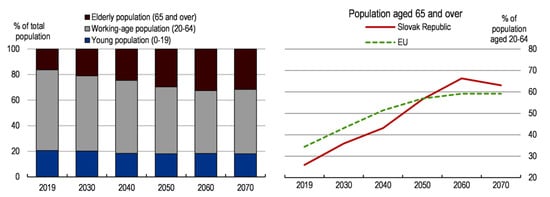
Figure 1.
Population ageing in Slovakia [3].
Currently (2023), the population of Slovakia is 5.465 million, among which 54% is urban and 46% rural [4]. The largest share of the urban population is concentrated in the capital city of Bratislava, where officially 423,737 people live. According to the data of mobile operators, calculated based on the number of active mobile sim cards, daily, 686,349 people stay or work in Bratislava [5]. The life expectancy in Slovakia is approximately 78 years, and the average age of the population is 41.39 [6] years. The aging is even more significant in the Bratislava region. While in 2006, the average age of the residents was 37.06 years, in 2022 it was 41.44 years, the median age was 42.5 years and share of population in the post-productive age being 19.35% [6]. Most seniors live in their home environment, but a significant portion also require continuous treatment due to being frail elderly or having cognitive diseases.
1.2. Action to Be Taken
AP-NURSE is a modular and straightforward monitoring tool for patients with Alzheimer’s and Parkinson’s diseases for home and medical applications. It encompasses ambient sensors that can monitor activity patterns, gas concentrations, humidity, temperature changes, and movement. It aims to simplify home caregivers or nurses’ work by monitoring the patient’s fundamental interactions with their environment during night or job duties, providing fast alerts about possible dangers and supporting the independent living of frail elderly. The development of the system started in 2020 as part of the niCE-life project. Before the development started, it was necessary to decide on the configuration of sensors in order to fulfil the needs of care centres as potential future users of AP-NURSE.
As the niCE-life project had ten regular and twelve associate partners, with the majority involved in caregiving and a few operating care centres and social homes, the most reasonable approach was to start from the experience of project participants. For this purpose, an electronic questionnaire using the LimeSurvey [7] online platform was created. The questionnaire consisted of 65 questions focusing on the type of diseases of treated patients/clients, the experience of the caregivers with IoT (internet of things) solutions, their needs, and requirements specific to their treated patients/clients.
In the survey, one-third of the respondents claimed that they already had experience with IoT solutions for monitoring their patients’ conditions. A total of 83% claimed that they would use IoT solutions for monitoring the conditions of their patients or clients in the future. (In Bratislava, the residents of the care centres are referred to as clients, in Warsaw as patients.) The results, illustrated in Figure 2, showed that the users of the IoT solution would prefer to use motion sensors the most. The following preferred sensors would be sound, gas, and temperature.
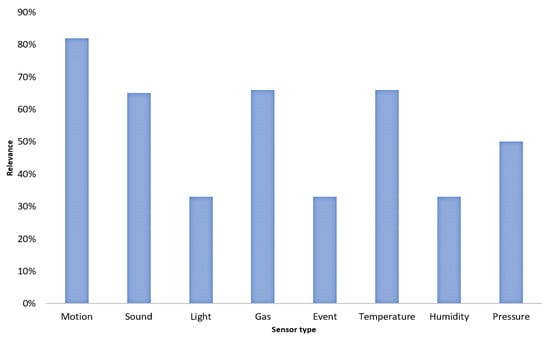
Figure 2.
Relevance of sensors for monitoring the patients.
In addition, most respondents claimed that the IoT solution should provide sound notifications to both the patient and the caregiver, and 33% of respondents thought it is appropriate to notify the caregiver only. In a system that provides notifications on a smartphone, tablet, PC, or laptop, the patient’s normal behaviour should be signalised by a green light on the screen. An abnormal condition of the patient should be signalised by a yellow light on the screen, with a modest alarm beep and message on a mobile phone. In some cases, it would also be preferable to provide a map of the location where the event was observed. The critical condition should be signalised by a red light, an intense alarm, and by message to a pager or a smartphone. It would also be essential to provide information on the patient, i.e., name, room number, and map.
2. Design of AP-NURSE
2.1. General Design Objectives
Considering the findings from the survey presented above and considering the budget available and the project timeframe, the main design objective for AP-NURSE was to develop a cheap and thus widely affordable solution that can monitor the basic interactions of the patient with the environment. It is even more crucial during the night or job duties to provide fast alert about possible dangers. Since AP-NURSE aims to be available for home users and care centres, the development led to two branches denoted as AP-NURSE Home and AP-NURSE Care. Both systems utilise ambient sensors, provide PC- or smartphone-based notifications, and allow data collection and analysis; however, the main difference is in the simplicity and, therefore, the price of the solution. AP-NURSE Care is a more robust but slightly more expensive device requiring an information system (IS) [8] to collect responses and provide notifications. AP-NURSE Home can also use the information system; however, the role of the IS can be replaced by a simple rubber bracelet, which identifies the incoming signal and warns the caregiver or a family member to take care of the patient by vibration. The AP-NURSE flowcharts are shown in Figure 3, where (a) represents the minimal configuration of AP-NURSE Home with only one sensor and a bracelet to provide notifications, and (b) the optimal configuration of AP-NURSE Home and AP-NURSE Care.
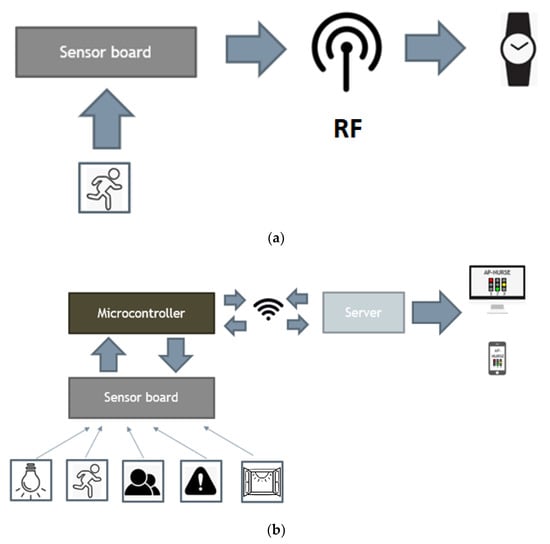
Figure 3.
AP-NURSRE flowcharts: (a) minimal configuration of AP-NURSE Home; (b) optima configuration of AP-NURSE Home and AP-NURSE Care.
2.2. AP-NURSE Versions
Based on the findings of the survey from Section 1.2, it was found that a single monitoring device could not sufficiently cover all application areas. For example, some monitored patients could be immobile or bedridden. Others could walk around the centre and enter dining areas, toilets, common rooms, and even outdoor premises. Another important fact is the difference in the daily and night routines of the patients and personnel. During the day, mobile patients are usually allowed to walk in the centre; however, night wonderings are dangerous and should be identified properly. Originally, eight AP-NURSE versions (AP1–AP8) were proposed in order to cover all desired application areas, each in three sub-versions, i.e., Home, Care–M5stack, and Care–Waspmote. Finally, four AP-NURSE versions (AP1, AP2, AP4, AP6) with eleven sub-versions were developed and prepared for testing. The summary of AP-NURSE versions is shown in Table 1. In the table, in the sub-version ID row, the postfix “H” stands for AP-NURSE Home, “M” for AP-NURSE Care–M5stack, and “W” for AP-NURSE Care–Waspmote. Each AP version is linked with a safety level. Breaching safety level 1 means that the patient or the client is not in bed; in the case of level 2, the patient is trying to leave the room; in the case of level 3, the patient is wandering; in level 4, the whole centre could be in danger due to a fire event.

Table 1.
Summary of AP-NURSE versions.
2.2.1. AP-NURSE Home
AP-NURSE Home is an original in-house solution, utilising the ESP8266 [9] microcontroller and PCB, designed and constructed directly at STU. The sensors are connected to the appropriate headers of ESP8266 directly or by extending cables to ensure an effective and portable casing for the whole device. The AP-NURSE Home unit usually consists of the base (ESP8266 and at least one sensor) and the wearable, which is a vibrational bracelet. The bracelet can be, however, replaced by the information system, designed for AP-NURSE Care, which provides specific warnings and notifications to the users. The power supply of the AP-NURSE Home base may be direct from the wall outlet or if necessary, from a power bank. The power supply of the AP-NURSE Home wearables is managed from the attached battery. There were four physical versions of AP-NURSE Home developed, and their block schemes are shown in Figure 4, Figure 5, Figure 6 and Figure 7.
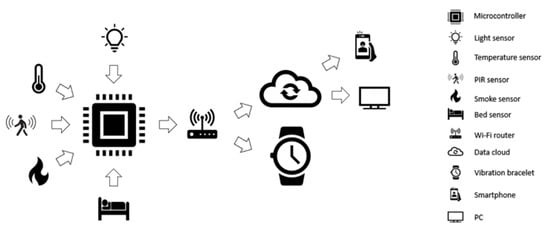
Figure 4.
Block scheme of the AP-NURSE Home AP-1H version.
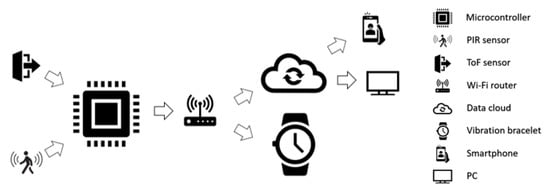
Figure 5.
Block scheme of the AP-NURSE Home AP-2H version.

Figure 6.
Block scheme of the AP-NURSE Home AP-4H version.
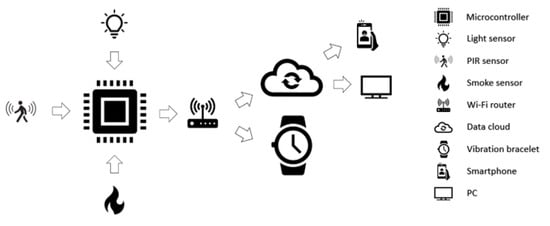
Figure 7.
Block scheme of the AP-NURSE Home AP-6H version.
The AP1-H version was configured with light, temperature, movement, and smoke sensors, as well as a pressure sensor installed on the mattress of the patient’s bed. Each sensor is physically attached to the ESP8266 motherboard, which is either connected to the Wi-Fi network and sends the data to the cloud or communicates with the bracelet worn by the caregiving personnel through a RF 443 MHz radio band with a maximal range of approximately 8 m. Due to the low power of ESP8266, a bridge server was implemented between the nodes and the main server to ensure the safe transmission of encrypted messages, first from the AP-NURSE device to the bridge and then from the bridge to the information system. The information system runs on the main server, installed in a physically and cyber protected location, and it treats the received data and translates the raw data into simple notifications, which can be visualised using the graphical user interface (GUI). The GUI can be operated on a PC, laptop, mobile, or tablet. This version of AP-NURSE Home aims to monitor whether patients/clients stay in bed. If the patient leaves the bed, the configuration of sensors makes it possible to warn the caregivers about movement in the room, opening the window, turning on the lights, turning on the gas stow, or lighting a cigarette.
AP2-H was designed to monitor whether the patients stayed in their rooms. Compared to AP1-H, it is a simpler version, configured only with one PIR (passive infra-red) or ToF (time-of-flight) movement sensor and is usually attached to a door leading to an escape route, such as a door from the room or to the balcony. It can also notify the caregiving personnel if the patient/client stacks in the toilet. Like AP1-H, the notifications can be provided using the bracelet worn by the caregiver, a family member, or the information system.
AP4-H was designed to be installed in corridors to monitor the movement of patients in the centre, mainly during night hours. AP4-H can be used in a house environment to identify if the patients started to wander to warm the family members. It is configured with only one PIR movement sensor. The communication and the management of warnings are similar to AP2-H.
The last version, AP6-H, has been derived from AP1-H but is significantly simpler. It requires only a PIR movements sensor, a light sensor, and a smoke sensor. This version has been designed to be used in a kitchen or premises, where the possibility of a fire event is considerable. In the basic design scenario of AP6-H, a patient lives in a home environment, gets up at night, walks into the kitchen, and turns on the gas stove. In such cases, the family member or caregiver is immediately notified.
2.2.2. AP-NURSE Care
AP-NURSE Care is a more mature solution designed for professional use with a long service life and higher reliability. These devices are based on two available modular systems, the M5Stack [10] and the Waspmote [11] platforms. M5Stack is modular stackable product development toolkits based on ESP32 [12]. The core units are equipped with several simple but robust M5stack sensors to meet the requirements of using AP-NURSE Care in care centres. The number of sensors per module is limited to five pieces. The configuration of sensors depends on the specific application; thus, each AP-NURSE version can be equipped with a unique configuration of sensors. The second hardware architecture selected for the AP-NURSE Care platform is the Waspmote, which has been specially designed for work with extremely low power consumption. Digital switches allow for turning on and off any of the sensor interfaces as well as the radio modules. The Waspmote platform supports more than 120 sensors and 15 wireless interfaces, but in the case of AP-NURSE Care Waspmote, the number of sensors per device was limited to five pieces. Seven AP-NURSE Care versions were developed (four AP-NURSE Care M5stack and three Waspmote). Their block schemes are shown in Figure 8, Figure 9, Figure 10 and Figure 11, and the list of sensors are shown in Table 2.
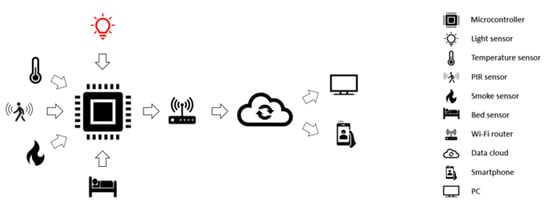
Figure 8.
Block scheme of the AP-NURSE Care AP1-M and AP1-W versions.

Figure 9.
Block scheme of the AP-NURSE Care AP2-M version.
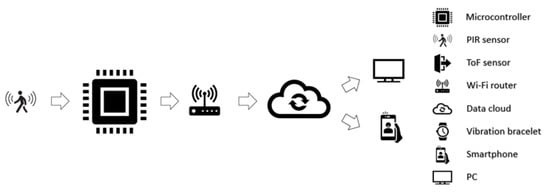
Figure 10.
Block scheme of the AP-NURSE Care AP4-M and AP4-W versions.
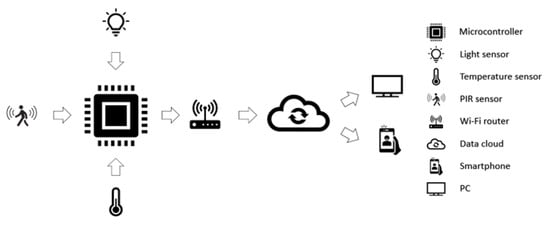
Figure 11.
Block scheme of the AP-NURSE Care AP2-M version.

Table 2.
Summary of AP-NURSE sensors.
The hardware configuration of AP1-M is created using the M5StickC Plus unit (called base), the battery holder or rechargeable 18,650 C HAT, and four sensors. Since this unit has been configured to monitor whether the patients/clients of the care centre stay in their beds, the AP1-M units are configured with a PIR movement sensor, temperature sensor, smoke sensor, and bed sensor. The AP1-M unit is connected to the data cloud through the local Wi-Fi network. The information system treats the data sent to the cloud, and the raw data are translated into simple notifications, which can be visualised using GUI. The AP1-W unit consists of the Waspmote motherboard, the wireless module, and the expansion module, which integrates sensors. In the case of AP1-W, five sensors are connected. Compared to AP1-M, AP1-W uses an extra light sensor (red colour) with a slightly different logic of triggering alarms but the same data cloud and information system.
AP2-M was designed to monitor the exit from the rooms to the corridors of the care centre or the balcony or garden. The centre’s garden and corridor are usually accessible to patients during the daytime; therefore, the alarm-triggering logic of AP2-M is set up for night shifts. AP2-M is configured only with one ToF movement sensor. If required, the ToF sensor can be replaced by a Hall Effect electromagnetic sensor attached to a door.
AP4-M and AP4-W have the same configuration of sensors. They are similar to AP2-M, with the difference that they use a PIR movement sensor and are designed to monitor the corridor of the centre or the escape routes from the controlled zone of the care centre. They are usually placed above the doors and can monitor the corridor from the top. Like AP2-M, these devices provide notifications only during night shifts.
AP6-M and AP6-W also use the same configuration of sensors and are installed in the centre’s cafeteria or dining room, where food is served to patients. Usually, these rooms have an electric kettle, microwave, or heater. Therefore, the AP6-M and AP6-W devices were configured with a PIR movement sensor, a light sensor, and an environmental sensor, which can measure changes in ambient temperature and humidity or concentration of gases. Signs of a fire event can be detected from the combinations of events. These AP-NURSE units are designed for 24 h monitoring.
2.3. AP-NURSE Versions
2.3.1. AP-NURSE Home
The AP-Nurse Home unit is fitted with custom-built firmware based on the ESP8266 Arduino core. Its firmware supports configurable multi-level alert warnings triggered by external or internal events. The firmware also supports data collection and remote alert notification using HTTPS requests in user demand. A more detailed description of the firmware is shown in Figure 12 on the left. On device boot, the ESP8266 initialises its peripherals and the AP-NURSE Home control object. After the unit is booted, the Wi-Fi network connection is in order. On successful network connection, the firmware enters its main program loop, consisting of unit stand-by and data update. During stand-by, the unit waits for data update, button command interrupt, or collected data dispatch HTTPS request. Once the data update has been initiated, the firmware reads all connected sensor outputs and evaluates them.
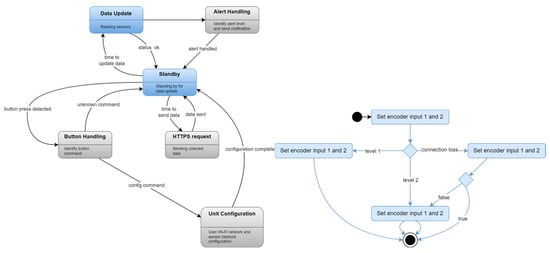
Figure 12.
Firmware and alarm handling diagram of AP-NURSE Home.
The alert handing diagram of AP-NURSE Home is shown in Figure 12 on the right. An alert notification is provided by controlling four HT12E RF communication encoder’s four data inputs that subsequently transmit the given notification. The AP-NURSE Home firmware also features a button handler to distinguish between multiple button commands. The present firmware version is configured only to respond to a long button press. This command triggers the unit configuration mode. The unit configuration uses a local server accessible through a Wi-Fi access point generated by the unit. Once connected, the unit can be configured using a standard internet browser.
2.3.2. AP-NURSE Care M5stack
The AP-NURSE Care M5Stack firmware is based on the ESP32 Arduino core. The firmware supports OTA Programming for convenient unit software upgrades. AP-NURSE Care M5Stack is capable of handling data acquisition with the use of a variety of supported sensors. The system supports configurable data advertisement intervals and regimes. A more detailed description of the firmware is shown in Figure 13 on the left, and the alarm handling diagram is shown in Figure 13 on the right.
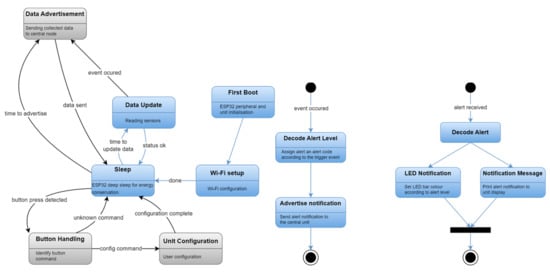
Figure 13.
Firmware and alarm handling diagram of AP-NURSE Care M5stack.
The unit firmware manages its main operation loop. After the units first boot, a user Wi-Fi provisioning configuration is in order. Once complete, the unit enters its main operation loop. The RTC timer of the ESP32 is configured to wake up the device to update measured data periodically. The measured data are advertised to the information system if a significant data swing is detected. Data advertisement also occurs in periodic intervals, in which the measured data are stored in the device’s flash memory, bypassing the need to advertise during every wake-up cycle, significantly reducing device power consumption.
Even further power conservation was achieved in the FW of the AP4-M unit using the PIR motion sensor output as an interrupt for ESP32 wake-up. However, this device also features periodic data advertisement for the so-called “deadbeat” (to let the information system know it is alive and operational). It supplies the system with information about its battery level. A long button press triggers the configuration of an M5Stack unit. As seen in the AP-NURSE Home unit, the configuration uses a local server accessible through a Wi-Fi access point generated by the unit. Once connected, the unit can be configured using any standard internet browser.
2.3.3. AP-NURSE Care Waspmote
The AP-Nurse Care Waspmote unit is fitted with a custom-built firmware based on the Waspmote API. It is capable of handling data acquisition with the use of a variety of supported sensors. The firmware supports data collection and periodical notification about current sensor states using HTTPS requests. In case of user demand, the firmware also supports alert warnings triggered by external events. The firmware state diagram is shown in Figure 14.
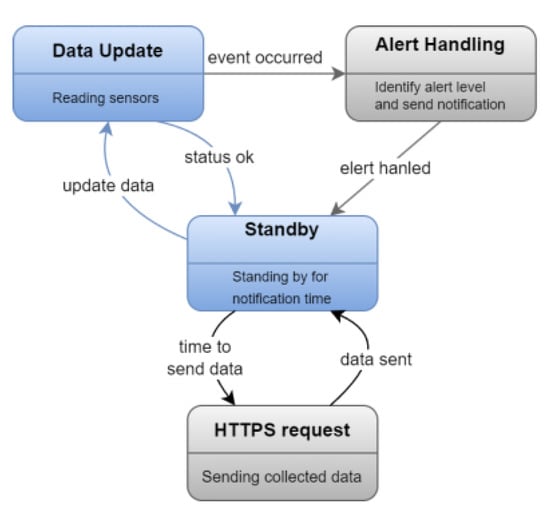
Figure 14.
Firmware state diagram of AP-NURSE Care Waspmote.
On device boot, the Waspmote initialises all peripherals and establishes network connection. After successful network connection, the firmware enters its main program loop. The main loop consists of two alternating states: data update and data sending. In each loop, the firmware reads all connected sensor outputs, evaluates them, and updates data package variables. The new core of the information system provides device and user authentication using elliptic curve cryptography (ECC). This way, on device creation, a pair of elliptic curve keys are generated: a private one, used for electronic signature generation (these signatures are subsequently used for request authentication), and a public one, used for the digital signature validation. The public key is then registered in the information system database and is later used for the verification of the device request authenticity. The private key never leaves the device. Hence, should the shared public key be compromised, the attacker has no access to the information system, for without the private key, no valid digital signature can be generated. The user interface features a device list, where all devices registered under a user account can be found. From here, an individual device detail screen is accessible, containing all relevant information.
2.4. AP-NURSE Casing
The casing for AP-NURSE was designed to cover and secure the hardware and to position sensors and buttons. During the development, the STU team focused on the mechanical stability, compactness, air permeability, and user friendly and effective distribution of buttons and other components. The final design provides easy access to all controllers, sensors, and other electronic parts. All parts of the casing are fixed by the press and click system. In the case of AP-NURSE Home, additional screw-based fixation is available. The positioning of the buttons, sensors, and other electronic parts is designed to eliminate the wiring length and the produced heat influence. The main PCB board for AP NURSE Home and AP NURSE Care is fixed by the screws inside the casing, and other parts are fixed by glue. On the bottom side of the AP-NURSE Home and AP NURSE Care casing, the slots for the press-and-click-based fixation of the battery holder are located. For 3D printing, PLA (polylatic acid) was used. The final casings for AP-NURSE Home, AP-NURSE Care, and AP-NURSE Home wearable are shown in Figure 15.

Figure 15.
Casing of the AP-NURSE Home and Care units.
2.5. AP-NURSE Information System
The data collection information system (IS) was developed to manage the operation of AP-NURSE devices, provide quick notifications to users, and analyse the gathered data from the devices. The client part allows the manipulation of devices quickly and intuitively via a web browser. The server part processes requests from the client, collects the necessary data from the IoT devices, and supplies the client part with the required device information. The IS also visualises data gathered by custom-configured AP-NURSE units. It allows for adding an arbitrary number of sensors communicating with the IS through a registered AP-NURSE device. The user interface allows for the creation of device “collections”, enabling device association to groups, each of which can be assigned its alerts. The information system allows for the clever evaluation of received raw sensor data, wherein the additional logic (parallel signals from different sensors, specific order of activated sensors, time difference between the signals) is applied to trigger the alarm in GUI. The screenshot from the IS is shown in Figure 16. More information about the IS can be found here [8].
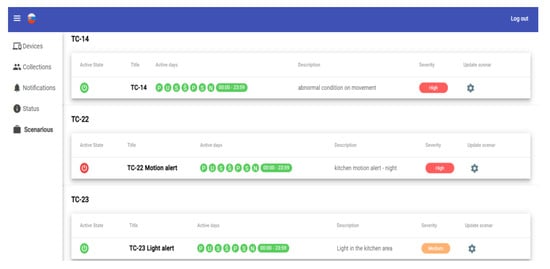
Figure 16.
Screenshot from the AP-NURSE information system.
3. Laboratory Testing of AP-NURSE
3.1. Testing Environment
To test the correct operations of sensors, micro-controllers, and communication modules used for AP-NURSE a special testing room was designed and prepared at STU. Before testing the AP-NURSE devices in care centres, it was important to gain practical experience with all prototypes and validate the prepared scenarios or test cases. Therefore, the laboratory testing went through all initialisation events, event chains, predictable or unlikely sequences of the events, and proposed caregivers’ responses, and it validated the thresholds and the ability of the whole system to operate in case of multiple events. Thus, the testing environment had to be similar to the real testing site. The testing room created at STU consisted of an adjustable bed, cabinets, armchairs, tables, washbasin, shelves, household appliances, power sockets, windows, and window blinds.
3.2. Testing Procedure
The testing procedure developed for the AP-NURSE Home and Care devices consisted of the following three phases: I—function tests, II—test cases; and III—sensor sensitivity tests.
3.2.1. Function Tests
Several functional tests were designed to be performed for every AP-NURSE Home and Care device. The selected tests aimed to verify the basic functionality and performance of the developed devices. These tests are based on the events according to carefully developed event flows. There were four basis event flows, from which 25 function tests were derived. All function tests were performed at least ten times, and the results were evaluated in test protocols. The example of event flow test numbers 3 and 4 is shown in Figure 17.

Figure 17.
Example of event flow tests 3 and 4.
3.2.2. Test Cases
A series of test cases were created to simulate the behaviour of AP-NURSE devices. These test cases served as a tool to find specific threshold values for sensors and test the general practical use of the AP-NURSE devices. Three criteria drove the selection of test cases:
- The location where the AP-NURSE devices are installed (on the wall, under the bed, etc.).
- Type of the patient (mobile/immobile).
- Monitoring regime (day/night).
According to specific applications, individual alerts can be muted. For example, walking in the room during the daylight. However, in general, the system must detect all events, and the device should decide, based on the implemented logic, whether to trigger an alert or not. After the testing procedure, it was important to set the threshold according to the specific placement of the device. Each AP-NURSE version had its own set of test cases, designed for testing in the physical testing environment of STU. The internal logic of the AP-NURSE motherboard was also adjusted for each version. The final list consisted of 35 test cases for AP-NURSE Home and 23 cases for AP-NURSE Care.
3.2.3. Sensor Sensitivity Tests
The sensors used for the AP-NURSE Home and Care were tested and measured against an available measuring device of appropriate quantity. These sensors included the PIR movement sensor, where the maximal and reliable detection angle was defined. This included the noise sensor; the light sensor, measured with a lightbulb, LED, and CFL sources; the temperature sensor; and the pressure sensor.
3.3. Testing Results
3.3.1. Function Tests
For the AP-NURSE Home and Care versions, 25 function tests were defined. Several tests had to be omitted per each version since they required specifics of a different version. For example, tests requiring the pressure sensor could be performed only for AP1-H, AP1-M, and AP1-W, and tests requiring the ToF sensor could be applied only for AP2-M. The results of function tests were evaluated as expected and unexpected. The results are shown in Figure 18.
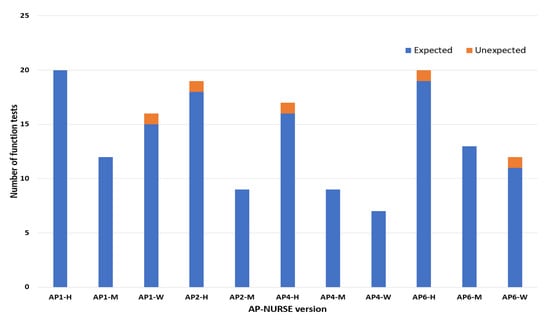
Figure 18.
Results of AP-NURSE function tests.
The function tests identified excellent performance of the AP-NURSE Home, AP-NURSE Care M5Stack, and AP-NURSE Care Waspmote devices in laboratory conditions. The average success rate of AP-NURSE Home was 96%, and only three unexpected results were achieved, each caused by the low sensitivity of the noise sensor. The success rate of AP-NURSE Care M5Stack was 100%, and the success rate of AP-NURSE Care Waspmote was 94%, with two unexpected results caused by the limited performance of the MQ5 air quality sensor. Based on these results, the function tests can be seen as successful.
3.3.2. Test Cases
Subsequently, test cases were defined and performed for all AP-NURSE Home and Care versions. The tests were evaluated as passed, failed, or limited, while the keyword limited represents a case where the test could be successful under specific circumstances. The results are shown in Figure 19. The overall pass rate of the AP-NURSE technology, including the ones with limited performance, was 75%. The pass rate of individual hardware platform was 64% for AP-NURSE Home, 83% for AP-NURSE Care M5Stack, and 80% for AP-NURSE Care Waspmote. It should be noted that the tests failed only in the case of AP1-H, AP1-M, AP1-W, and AP2-H devices. The tests for the remaining versions all passed. The failed tests were caused in most of the cases by the humidity sensor and the detection angle of the AP1 PIR sensor. This problem was solved in the testing in a real environment by correctly placing the devices under the patients’ beds. In general, it should be concluded that the test cases showed valuable results and the achieved success rate is acceptable.
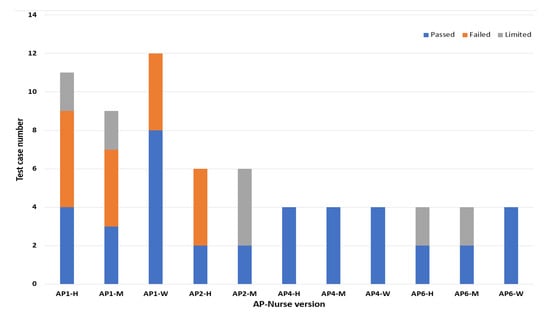
Figure 19.
Results of AP-NURSE test cases.
3.3.3. Sensor Sensitivity Tests
The AP-NURSE sensor sensibility tests were carried out for the PIR (movement), noise, light, temperature, and pressure sensors. In the case of the PIR sensor, it was found that placing the device further from the source was not helpful as the so-called reliable detection distance represents the distance in which the signal was detected in the case of each test. The test of the light sensors showed that the sensor strongly depends on the type and quality of the light source; therefore, its parameters must be set based on the specifics of the real application site. The temperature sensor was appropriate for the broad temperature range (approximately 10–40 °C), even though its response time is not short. The tests also confirmed that the pressure sensor is a good choice for monitoring the patients in bed. However, the sensor should be placed correctly. Finally, it was found that, in the real application, the ToF sensor needs to be separately calibrated according to the environments in which it is used.
3.4. Finalisation and Prototype Production
After the completed tests, the porotype production started. The production process of AP-NURSE Home devices was divided according to individual PCB boards for the AP-NURSE Home base and the AP-NURSE Home wearables. The production started with clean PCB boards, continued with mounting the SMD components, and verified the functionality using in-circuit testing. Regarding the AP-NURSE Care platform, only the battery holder required PCB production. The assembling of AP-NURSE Home devices started with the initial testing of each sensor. First, the headers had to be removed from the peripheral sensors and components and replaced by a cable that provided an input connected to the PCB board. The finalisation of AP-NURSE Care M5stack and Waspmote devices was done based on the technical documentation provided by the manufacturer and the sensor connection and encapsulation scheme prepared by STU. The core units with connected sensors were precisely placed in the 3D printed casing. In the final step, the software was installed for each device, based on the intended application. Finally, production tests were established to complement the production process.
4. Testing in Real Environment
4.1. Definition of the Testing Pilots
4.1.1. The Aim of the Pilots
The next step in developing AP-NURSE devices was testing in the real environment, called pilot testing. Its aim was to evaluate the features of AP-NURSE for patients suffering from dementia, Parkinson’s disease, and Alzheimer’s disease, or frail elderly who require care or treatment. The next aim of the pilot was to find out whether AP-NURSE can simplify the work of caregivers in institutional care. The pilots had the following eight objectives:
- To install the AP-NURSE smart monitoring tool in two pilot sites and to maintain it in operation as long as possible, but at least two months without interruption.
- To test the information system designed to collect data from AP-NURSE devices.
- Train the selected centres’ personnel to use the information system and the AP-NURSE devices, maintain the nodes in operation, and provide sufficient feedback.
- Collect feedback from the caregivers and the representatives of the centre.
- Based on feedback from caregivers, further improve the system.
- Collect and analyse operational data from the devices.
- Determine whether the system has improved the work of caregivers.
- Identify areas of further development and conditions to be used in the care centre.
4.1.2. Overview of the Testing Sites
Two sites were selected for testing, the Social Care Centre in Bratislava (SCC) and the Social Care Home in Warsaw (SCH). The Social Care Home in Warsaw has been part of the Alzheimer’s Centre of Warsaw since 1 June 2011. It is a co-educational facility for 120 chronically ill people, especially those suffering from dementia or Alzheimer’s disease. The services provided include 24 h care; nursing and care activities; food (three meals a day, including diets); and health, psychological, pastoral, and social care. The total number of patients treated in the SCH at the time of testing was 117, out of which there were 75 female and 42 male patients. A total of 47 people were bedridden, 52 were walking with support, and 18 were without support.
Regarding the age structure, 5 patients were less than 60 years old, 45 were between 60–79 years, and 67 were over 80 years old. The pilot testing of AP-NURSE devices was performed in building 1 of the Social Care Home. This building is in a controlled area and is connected to the park and the administration building through two corridors (main and side) with doors allowing the passage of authorised personnel only. In the controlled area, seven monitoring zones were selected, which are shown in Figure 20. In these zones, four monitoring levels were set up: I—monitoring of patients in their rooms, II—monitoring of intersections of corridors, III—monitoring of emergency exits, and IV—monitoring of kitchens and dining rooms. In level I, only the patients were monitored, but in levels II–IV, also the staff of centre using the corridors were under surveillance.
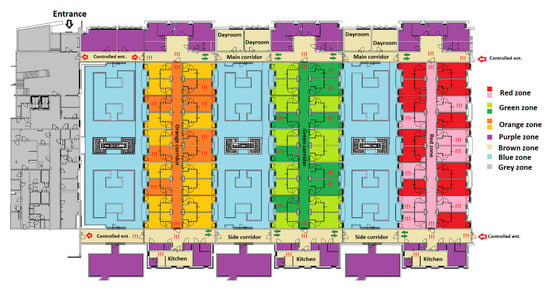
Figure 20.
The building of the Social Care Home in Warsaw. The symbol !!! indicates the place where the AP-NURSE is located. The Green Arrows indicates the allowed direction of movement.
The second pilot was performed in the Social Care Centre Bratislava, which is involved in caregiving for elderly people with a broad range of diseases. The total capacity of the centre is 30 people. The clients are accommodated in single or double rooms based on age, disease, mobility, and daily activity pattern. During the pilot, the age of clients varied between 63 and 100 years, with the average age of clients being 82 years, out of which the average age of female clients was 83 years, and the average age of male clients was 80 years. The centre generally treats mobile, partially mobile, and immobile patients with chronic and post-traumatic diseases of low and intermediate severity. The building of the Social Care Centre Bratislava is shown in Figure 21. The centre is located on two floors, where the following monitoring levels were set up: I—monitoring of mobile clients in rooms, II—monitoring of immobile clients in rooms, III—monitoring of corridors, IV—monitoring of kitchens, and V—monitoring of restricted areas. Level I and II involved monitoring of patients only, whereas levels III–V also included the monitoring of the centre’s staff.
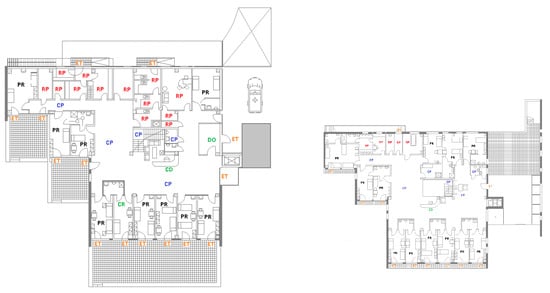
Figure 21.
The building of the Social Care Centre in Bratislava. A different color means a different zone in the center and a different way of monitoring patients.
4.1.3. Installation of Devices
The installation and testing of the AP-NURSE devices in both pilots were performed based on a specific procedure. It consisted of the selection of the rooms, installation, testing of functionality, and replacement if necessary. The summary of monitored targets involved in the pilots is shown in Table 3, and the summary of installed devices in the pilots is in Table 4. Photos of the installed AP-NURSE devices from the pilot are shown in Figure 22.

Table 3.
Summary of monitored targets in the pilots.

Table 4.
Summary of installed devices in the pilots.
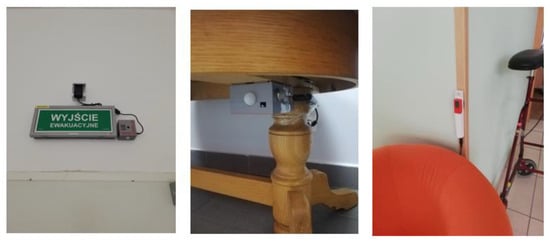
Figure 22.
Photos of the AP-NURSE devices from the pilots. It means “EXIT”.
4.2. Evaluation Procedure
Local Indicators
The local indicators for the pilot were defined based on the set objectives and in cooperation with the involved project partners. Their relation is shown in Figure 23. Regarding technology acceptance and usability, a tailored questionnaire was created using the LimeSurvey online open platform. The technology reliability of AP-NURSE was evaluated using electronic forms to monitor the status of devices. In this status, monitoring forms two criteria were evaluated, whether the devices are online and whether they send and receive the data packages correctly. In terms of accuracy, the responses of caregivers were collected on a two-weeks basis. The role of the caregivers was to confirm or refute the correctness of the notifications. The applicability was evaluated based on the quality of the gathered data from the devices. The evaluate these indicators the following success criteria were defined:
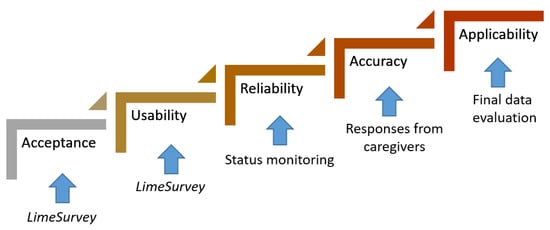
Figure 23.
Relation of local indicators. The arrows indicate the source from which we obtained inputs for the evaluation of this criterion.
- Acceptance -> confirmed by 60% of respondents.
- Usability -> confirmed by 70% of respondents.
- Reliability -> operational 70% of the time.
- Accuracy -> Rate of false alarms <20%.
- Applicability -> Confirmation of a specific event from at least two sensors or one sensor and caregivers.
4.3. Results of the Evaluation
4.3.1. Warsaw Pilot
During the monitoring in SCH Warsaw, 11,940 notifications were collected in the IS. This represents 244 notifications per AP-NURSE device. Among all notifications, 96.93% were evaluated by the caregivers as correct notifications and 3.07% as false alarms. A total of 60% of the notifications came from the AP-NURSE Home platform, 30% from the AP-NURSE Care M5stack, and only 10% from the AP-NURSE Care Waspmote platform. Even though 43% of the installed devices were AP-NURSE Care M5stack units, most of the notifications came from the AP-NURSE Home platform. Regarding versions, 44% of notifications came from AP1 devices, 30% from AP4 devices, 18% from AP2 devices with Hall Effect sensors, 4% from AP6 devices, and 2% from AP2 devices with ToF sensors. The summary of local indicators from the Warsaw pilot can be found in Table 5.

Table 5.
Summary of local indicator from the Warsaw pilot.
It should be noted that due to technical problems, mainly battery issues, and wrong sensor setting, the AP6 and AP2 versions were retired during the testing procedure. In the case of AP6 devices, the issues with the battery resulted in a lack of notifications, and in the case of AP2, the wrong sensor threshold led to false alarms. Considering all criteria, it can be concluded that the AP1 and AP4 devices met and passed the evaluation procedure. Nevertheless, there is a space for improvement for these devices. For commercialisation, improving their accuracy and reliability will need to exceed at least 95%. Unfortunately, the AP2 and AP6 devices failed the evaluation; however, after some modifications and upgrades, these devices can be further tested and used in practice.
4.3.2. Bratislava Pilot
During the monitoring in SCC Bratislava, 254 notifications were collected, representing 18 notifications per AP-NURSE device. The lower number of evaluated notifications compared to the Warsaw pilot was caused by the requirement to reinstall all devices due to measures taken in the centre to mitigate the emerging COVID-19 situation. Among all notifications, 81.42% were evaluated by the caregivers as correct notifications and 18.58% as false alarms. It was found that 77% of the notifications came from the AP-NURSE Home platform and 23% from the AP-NURSE Care platform. Regarding versions, 77% of notifications came from AP1 devices and 23% from AP4 devices. The summary of local indicators from the Warsaw pilot can be found in Table 6. Here, the acceptance and the usability criterion were evaluated for the whole AP-NURSE system. However, due to the complexity of the installation and operation of AP-NURSE devices, the reliability, accuracy, and applicability were evaluated separately for each version.

Table 6.
Summary of local indicator from the Bratislava pilot.
All versions met the acceptance and usability criteria. However, AP2 and AP6 could not meet the reliability, accuracy, and applicability criteria. This was caused by the wrong sensor threshold of AP2 and by high humidity in the kitchen, leading to false alarms from AP6. AP1-H and AP4-M devices met all the criteria and passed the evaluation procedure. Nevertheless, there is a space for improvement for these devices. For commercialisation, improving their accuracy and reliability will need to exceed at least 95%. Unfortunately, the remaining devices failed the evaluation; however, after some modifications and upgrades, these devices can be further used.
4.4. Collected Feedback
4.4.1. False Alarms
For data analysis, mainly to evaluate the local indicators, caregiver forms were distributed to the Social Care Home Warsaw and Social Care Centre Bratislava personnel, collected on a two-week basis and evaluated by the STU team. These forms were also used to analyse the reported errors individually. Over the monitored period, 529 errors were encountered in Warsaw and 47 in Bratislava. These errors can be divided into four categories:
- False alarms: open balcony, patient not in bed.
- Missed notifications: movement, leaving the bed.
- Physical damage: dismantled sensor, unplugged device.
- Other: system errors, delays, failed restart, etc.
Among all errors in Warsaw, 2/3 represented a missing notification for movement in the room for AP1. The second most frequent error was a false alarm for an opened balcony. To find out the cause of these errors, the STU performed an analysis, which revealed that in the case of AP2 devices, a faulty sensor setting was used, which could have been corrected by the recalibration of sensors. It was also found that the missing notifications were caused by the wrong orientation of the PIR and ToF sensors, which can be mitigated by proper maintenance. From the 48 false alarms reported in Bratislava, the majority corresponded to a false alarm indicating that the patient was not in bed and a false alarm reporting a fire event in the kitchen. Similarly to the Warsaw pilot, here, the false alarm of a patient leaving the rom was caused by the wrong orientation of the PIR sensor.
4.4.2. Verbal Feedback
The verbal feedback was collected using the LimeSurvey online questionnaire by answering three questions. For the question “What would you change, modify or correct on the interface of the Information System?”, 12 verbal responses were collected; however, the majority (10 out of 12) concluded that they were satisfied and would not change the system. The remaining two respondents claimed they would appreciate it if the notifications in the IS would relate to a sound alarm. Regarding the advantages of the AP-NURSE system, the following answers were the most frequent ones:
- Easier or better control of clients Easier or better control of clients.
- Better monitoring of clients at night.
- Better control of the working shifts.
- Better overview of what is happening in the centre.
- Prompt handling of exceptional situations.
In terms of the disadvantages of the AP-NURSE system, the following responses were collected:
- False alarms.
- The failure rate of the system.
- Generality of messages.
- Checking the detectors too frequently.
- Patients can dismantle the equipment.
Regarding the maximal price of the AP-NURSE system, the respondents claimed prices in a range between EUR 100 and 10,000 with an average price of EUR 1905 and a median of EUR 650. Due to the EUR 2894 standard deviation, it is impossible to judge whether the respondents claimed the price of one device or the whole system.
5. Deployment and Commercialisation
At the beginning of the niCE-life project implementation, a survey of the available technical solutions on the market was performed (available in D.1.3.1 of the niCE-Life project [2]). The results of the survey may be summarised as follows. There already exist many possibilities on how to track the movement of the patients, how to partially monitor them, and how to process all the data and alert the right personnel. Most of the systems use GPS tracking combined with an attachable device to a patient clothes/shoes/body as a vital component, which is an advantage when the patient has no intention to get rid of such devices and therefore can be monitored in a limited way also outside the house. These systems are therefore designated for patients, or elderly people, with not-so-serious diagnoses. If considering a strongly diseased patient with Alzheimer’s or Parkinson’s disease, such devices are not sufficient to monitor the patients’ behaviour, such as opening the doors and windows, turning on the gas, or other hazardous situations. Although some systems offer similar peripheral sensors, they are expensive. Many systems also offer smartphone and computer applications for reporting or monitoring purposes. However, none of the studied devices already obtained CE marking for medical devices valid in the EU.
Naturally, AP-NURSE tried to fill the gaps identified in the survey. The most challenging part of the development itself was the sustainability and introduction of the newly developed tool into the market. The successful work done serves as steppingstone for the further commercialisation of this system; however, several technical issues, precisely identified during the testing in real environment, need to be solved. The technical readiness level of AP-NURSE reached TRL-6 or TRL-7. Anyhow, to reach the market introduction, further TRL levels (TRL 7-9) need to be reached to finalise the tool.
To perform the first thought experiment, the Bratislava region was analysed. With a population of 686,349 as of 31 December 2020 [5], the Bratislava region accounted for 12.4% of the total population of Slovakia. Approximately 15.5% of the population of the Bratislava region is in the post-productive age (above 65y). Regarding the demand for such devices and according to a web search, there are more than 25 retirement homes and care centres in the Bratislava region and 3 specialised geriatric clinics. It is important to note that almost every location in the Bratislava region could be reached by car in less than one hour, which allows for the establishment of just one technical support centre near the geographic centre of the region. Based on these facts, we assume the potential to implement the AP-NURSE solutions as relevant where the density of the relevant institutions and the number of frail elderly people allow for the sustainable and cost-effective first implementation of the AP-NURSE system. The further exploitation of the system can then be performed also in the more rural villages and regions with a lower density of inhabitants.
Respecting the nature and the current stage of the development of AP-NURSE solutions and the following aim to introduce the tool to the market, several important steps need to be performed as follows:
- Implementation of small technical upgrades to the devices and information system based on the results from the pilot action.
- Development of blueprints for mass production.
- Final testing in the real environment.
- Selection of the production company with an implemented QA system.
- Certification according to the EU Medical Devices Regulation (MDR 2017/745).
Based on the steps defined above, the initial investment costs needed to introduce the AP-NURSE solution to the market and allow its sustainability were calculated to be EUR 150,000. Principally, two pricing strategies exist, differing in the need to cover initial investments by a loan or the availability of a starting grant. Based on the above-mentioned assumptions and that the investments costs must paid from the proceeds, it seems that at least eight parallel implementations with 50 devices each without the need of continuous support make the critical mass, allowing for the financial sustainability of the AP-NURSE tool in the Bratislava region. Further details can be found in the deliverable D.T4.2.4 of the niCE-Life project [2].
6. Conclusions
This paper summarised the development and testing of the AP-NURSE intelligent monitoring device aimed to increase the quality of everyday life of patients suffering from Alzheimer’s and Parkinson’s diseases, frail elderly, and those who take care of such patients. The first part of the paper presented Slovakia’s demographic information. It highlights that population ageing is starting to be a significant issue, which will require measures for mitigating its consequences at local and European levels. It described the final design of AP-NURSE Home and Care, defines its versions, selects based on the needs of potential users, and provides details on the hardware and software implementation. Currently, there are four versions of the AP-NURSE Home platform (AP1-H, AP2-H, AP4-H, and AP6-H), four versions of the AP-NURSE Care M5Stack platform (AP1-M, AP2-M, AP4-M, and AP6-M), and three versions of the AP-NURSE Care Waspmote platform (AP1-W, AP4-W, and AP6-W).
In the next part, the procedure of laboratory testing was presented. A set of function tests, test cases, and sensor sensitivity tests carried out at the special testing room created at STU are described. For the AP-NURSE Home and Care versions, 25 function tests were defined. The results of function tests were evaluated as expected and unexpected. The function tests identified the excellent performance of the AP-NURSE Home, Care M5Stack, and Care Waspmote devices. The average success rate of AP-NURSE Home was 96%, and only three unexpected results were achieved, each caused by the low sensitivity of the noise sensor. The success rate of AP-NURSE Care M5Stack was 100%, and the success rate of AP-NURSE Care Waspmote was 94%, with two unexpected results caused by the limited performance of the MQ5 air quality sensor.
Subsequently, test cases were defined and performed for all AP-NURSE Home and Care versions. The tests were evaluated as passed, failed, or limited, while the keyword limited represents a case where the test could be successful under specific circumstances. The overall pass rate of the AP-NURSE technology, including the ones with limited performance, was 75%. Individual hardware platform pass rate was 64% for AP-NURSE Home, 83% for AP-NURSE Care M5Stack, and 80% for AP-NURSE Care Waspmote. It should be noted that the tests failed only in the case of AP1-H, AP1-M, AP1-W, and AP2-H devices; the tests for the remaining versions were all passed. In general, it should be concluded that the test cases showed valuable results, and the achieved success rate is acceptable. It was also found that all tests strongly depended on placement and sensor sensibility.
The last part of the paper dealt with testing the AP-NURSE technology in real environments. Two sites were selected for testing, the Social Care Centre in Bratislava (SCC) and the Social Care Home in Warsaw (SCH). This chapter described the installation procedure and performance evaluation based on local indicators. These local indicators were technology acceptance, usability, reliability, accuracy, and applicability. For each indicator, a specific evaluation procedure was defined. The data for the evaluation of indicators were gathered using a targeted LimeSurvey online questionnaire, caregiver forms collected regularly, and through the evaluation of notifications and raw data from the information system used for the management of AP-NURSE units. The results showed that the AP1 and AP4 devices met all the criteria and passed the evaluation procedure.
Nevertheless, there is a space for improvement for these devices. It will be necessary to improve their accuracy and reliability to exceed at least 95% for commercialisation. Unfortunately, the remaining devices failed the evaluation. However, after some modifications and upgrades, these devices can be further tested and used in practice.
The most important finding of the testing was that most caregivers in both pilots had positive thoughts about the AP-NURSE system. In the online questionnaire, they claimed that AP-NURSE “eased the control of clients”, “increased their safety”, “gives a better overview of what is happening in the centre”, “can promptly handle dangerous situations”, or “it shortens the reaction times of the staff in case of an event”. At the same time, they claimed that there were some outages of the system and would require sound notifications. All the required features will be implemented in the future.
The participation of the STU team in the Interreg niCE-life project stimulated the technical development, which has brought relevant results able to improve the quality of life of the vulnerable elderly population. Moreover, implementing the AP-NURSE system brought caregiving to the 21st century. Technically simple but logically advanced devices could decrease the response time of the caregivers and the stress of the Care Centre staff. The technical development performed was based on the actual needs acquired during the early stages of the project and was translated to the construction of AP-NURSE tools accompanied by a robust information system. The complexity of the needs was surprising for the STU team; thus, significant knowledge and experience were gathered and further developed. The identified needs in care centres outside the project focus served as motivation for several diploma theses offered to students and then successfully defended. Moreover, the enormous amount of raw data collected might be used in further research where techniques such as machine learning could be used to identify specific patterns in the sensor signals and thus might improve the effectiveness of detection of dangerous situations.
The system and tools implemented are thoroughly described in this paper and may serve as a steppingstone for the further commercialisation of this system. Several technical issues need to be solved but were precisely identified during the testing in a natural environment. We consider the technical level reached as TRL-6 or TRL-7. We strongly believe that after further improvement, the AP-NURSE tool developed in the niCE-life project will become a helpful tool and ease the everyday life of chronically ill people treated either in care centres or in their home environments as frail elderly in general.
Author Contributions
Š.Č.—management over the development process, versioning, drafting the manuscript; B.V.—development of the conceptual design; J.L.—development of testing and evaluation methodology; M.V. (Marián Vojs)—development of the software, evaluation of results; M.V. (Martin Vrška)—production of AP-NURSE prototypes; M.B.—development and production of AP-NURSE casing; M.C. and J.B.—of the devices in laboratory conditions, installation of devices in the real environment; F.J.—expert advisor, L.M. and G.G.—development maintenance and utilisation of the dedicated information system for the operation of AP-NURSE devices. All authors have read and agreed to the published version of the manuscript.
Funding
This research was funded by the international project niCE-Life: “Development of an integrated concept for the deployment of innovative technologies and services allowing independent living of frail elderly” CE1581 within the INTERREG Central Europe Programme.
Data Availability Statement
The data presented in this study are available on request from the corresponding author. The data are not publicly available due to the written consent signed between STU, the Social Care Centre in Petržalka and the Social Care Home in Warsaw.
Acknowledgments
The authors would also like to thank R-DAS, s.r.o., for the support and provision of the framework for the development and test of the presented solution.
Conflicts of Interest
The authors declare no conflict of interest. The funders had no role in the design of the study; in the collection, analyses, or interpretation of data; in the writing of the manuscript; or in the decision to publish the results.
References
- Population Projections in the EU. Available online: https://ec.europa.eu/eurostat/statistics-explained/index.php?oldid=497115#Population_projections (accessed on 27 July 2023).
- NiCE-Life Project. Available online: https://programme2014-20.interreg-central.eu/Content.Node/niCE-life.html (accessed on 27 July 2023).
- Hwang, H.J.; Roehn, O. OECD Economic Surveys: Slovak Republic 2022; OECD: Paris, France, 2022. [Google Scholar]
- Wordlometer Femographics. Available online: https://www.worldometers.info/demographics/slovakia-demographics/ (accessed on 27 July 2023).
- Open Data Bratislava. Available online: https://opendata.bratislava.sk/en/page/people (accessed on 27 July 2023).
- STATdat. Available online: http://statdat.statistics.sk/cognosext/cgi-bin/cognos.cgi?b_action=cognosViewer&ui.action=run&ui.object=storeID%28%22iF41FA7A868E74315A56CF26B722E3A07%22%29&ui.name=Indexy%20vekov%C3%A9ho%20zlo%C5%BEenia%20-%20SR%2C%20oblasti%2C%20kraje%2C%20okresy%2C%20m (accessed on 27 July 2023).
- LimeSurvey: An Open Source Survey Tool. Available online: http://www.limesurvey.org (accessed on 27 July 2023).
- Kachman, O.; Findura, J.; Balaz, M.; Gyepes, G.; Majer, L.; Vojs, M. Inteligent Monitoring System for Universal Data Collection and Analysis. In Proceedings of the Inteligent Monitoring System for Universal Data Collection and Analysis, Košice, Slovakia, 21–22 April 2022. [Google Scholar]
- Expressif Inc. ESP8266 Technical Refefence V 1.7, 2020. Available online: https://www.espressif.com/sites/default/files/documentation/esp8266-technical_reference_en.pdf (accessed on 27 July 2023).
- M5Stack. M5Stack, Shenzen, China, 2023. Available online: https://m5stack.com (accessed on 27 July 2023).
- Libelum. Waspmote Technical Guide, Zaragoza, Spain, 2019. Available online: https://development.libelium.com/waspmote-technical-guide/hardware (accessed on 27 July 2023).
- Expressif Inc. SP32 Technical Reference Manual V5, 2022. Available online: https://www.espressif.com/sites/default/files/documentation/esp32_technical_reference_manual_en.pdf (accessed on 27 July 2023).
Disclaimer/Publisher’s Note: The statements, opinions and data contained in all publications are solely those of the individual author(s) and contributor(s) and not of MDPI and/or the editor(s). MDPI and/or the editor(s) disclaim responsibility for any injury to people or property resulting from any ideas, methods, instructions or products referred to in the content. |
© 2023 by the authors. Licensee MDPI, Basel, Switzerland. This article is an open access article distributed under the terms and conditions of the Creative Commons Attribution (CC BY) license (https://creativecommons.org/licenses/by/4.0/).